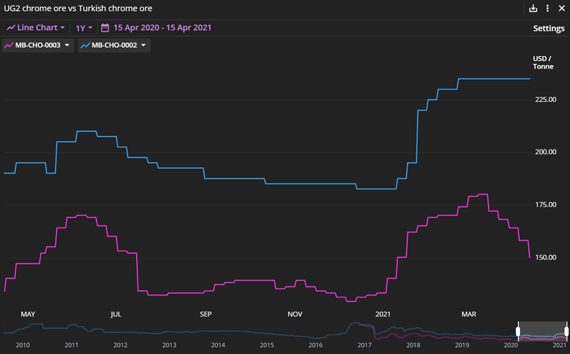Fastmarkets’ chrome ore South Africa UG2 concentrates index basis 42%, cif China was calculated at $150 per tonne on Tuesday April 13, after declining by $30 per tonne (20%) over the past five weeks from $180 per tonne on March 9.
At the same time, Fastmarkets’ assessment for chrome ore Turkish lumpy 40-42%, cfr main Chinese ports has held steady for the past seven weeks since rising to $230-240 per tonne on February 23.
The divergence in prices has led to an $85-per-tonne difference, marking the widest gap between both markets since May 2018.

“The difference had been much higher in the past. It narrowed as the proportion of ore consumed from South Africa increased, and other producers cut their premium,” a Turkish ore producer source said.
Limited supply
The availability of Turkish chrome ore has fallen with the country’s ore production shrinking in recent years, market sources told Fastmarkets.
“The poor market conditions in the past couple of years have squeezed out many small-sized producers, leaving large players who are more determined to sell only at good prices,” a Chinese ore buyer said.
Turkey produced 6.3 million tonnes of chromium in 2020, a drop of 37% from the 10 million tonnes produced in 2019, according to a mineral commodity report published by US Geological Survey (USGS) in January.
“Production has shrunk rapidly. Most of the miners stopped production and left the mine sites,” a second Turkish ore producer source said.
Meanwhile, South Africa produced 16 million tonnes in 2020, a fall of only 395,000 or 2.41% from 2019, according to the same USGS commodity report.
Chrome ore inventory at China’s Tianjin port was around 2.78 million tonnes on April 19, in which South Africa-origin chrome ore, at approximately 2.30 million tonnes, accounted for 82.49%, compared with a mere 140,010 tonnes (5.03%) of Turkey-origin chrome ore, according to inventory data submitted by market sources.
“The gigantic supply of UG2 makes it more vulnerable to a price fall, unlike Turkish chrome ore which has rather limited supply,” a second Chinese ore buyer said.
Freight rates
Meanwhile, freight rates from Turkey to China have increased more significantly than for South African producers, which has disproportionally pushed up costs for Turkish ore suppliers.
“Freight rates for container shipment have more than tripled from $20 [per tonne] to $70 or $80 [per tonne]. Therefore, some large-scaled suppliers are now using bulk shipments for their cargoes, which is also very expensive at around $50 per tonne,” a Turkish chrome ore trader said.
“Admittedly, freight rates from South Africa to China have also shot up, but the increase is less significant,” he added.
High costs mean Turkish producers have little flexibility to lower their prices.
“There is only so low Turkish material can go down and with higher freight costs, higher ratios and very little supply, they have been able to ensure a higher premium to South African material,” a second trader said. “I would say the lack of supply ex Zimbabwe, Albania and Pakistan is also a factor as they are competing with these countries for demand from the higher-grade buyers.”
Good demand
Apart from the supply issue, demand for Turkish chrome ore has improved after high ferro-chrome prices have incentivized smelters to use chrome ore with a high chrome-to-iron ratio to increase their alloy output.
“Smelters are trying their best to improve their output to lock in today’s fat profits, which led to increased buying appetite for Turkish ore, as well as other high-grade material,” a chrome ore trader source said.
Additionally, the usage of high-grade chrome ore can help smelters in Inner Mongolia, an autonomous region of northern China, where there are restrictions on energy consumption, Fastmarkets heard.
“Inner Mongolia has set maximum consumption of energy and electricity for each smelter, hence many of them prefer to use high-grade ore or ore with higher chrome-to-iron ratio because they get more alloy output per each kilowatt-hour they consume,” a ferro-chrome trader said.
Improved demand for Turkish material as well high costs mean Turkish producers have sought to maintain their prices.
And the current price premium of Turkish lumpy to UG2 ore can be expected to remain as long as Chinese consumers need higher grade material, according to market participants.
“This will continue. And if Chinese customers put more pressure on the prices, soon they will not be able to find any high grade materials,” the second Turkish ore producer said. “The miners just want compensation for the freight nothing else.”
Market participants have voiced differing opinions about the volumes of material that Turkish producers will sell and whether they can reclaim some market share from South African producers.
“I expect the Chinese will buy more and buy high-quality chrome in order to lower their electricity usage or UG2 will fall further in price,” the first producer source said.
But other market participants doubted whether the share of Turkish lumpy in the market can increase especially if prices cannot come down.
“While Turkey used to be the biggest supplier of ore to China, consumers have learned to live without it,” a South African ore producer source said. “There is no doubt, Turkish producers face higher costs, which they have tried to pass on through higher prices. However, consumers have moved away from their material so it is destroying demand.”
